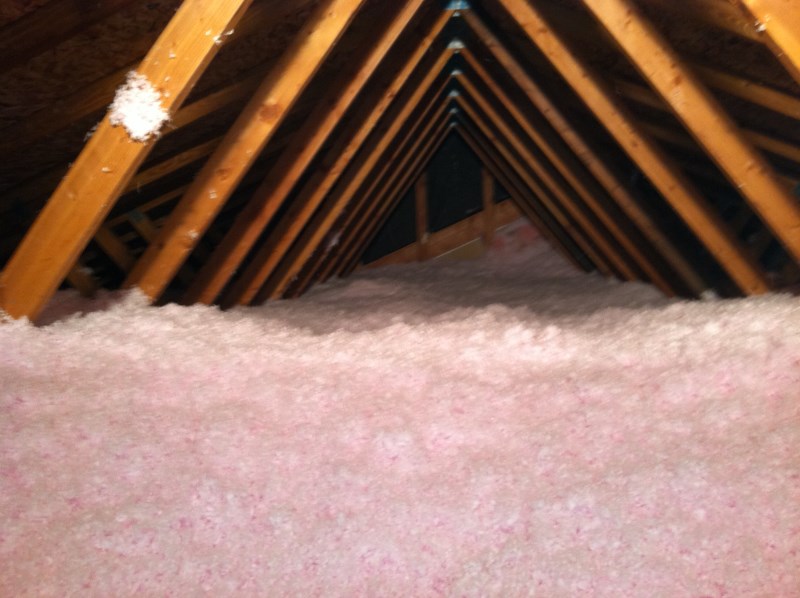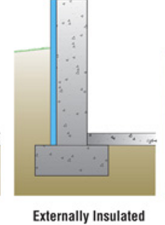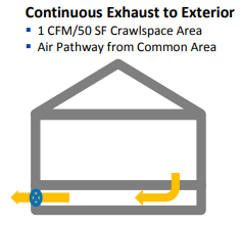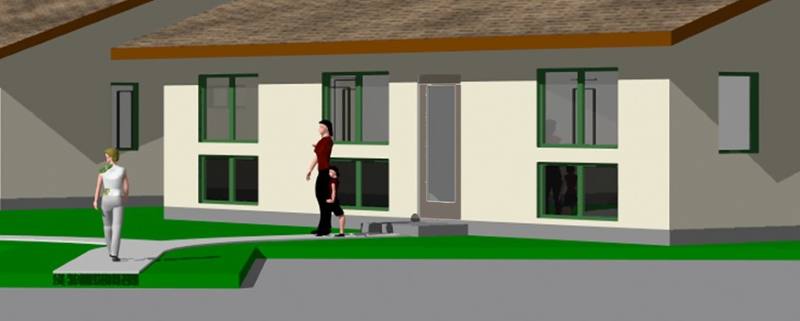Temperature Control
Montana has published the Montana Residential Energy Code Handbook . Blacktail Solar Homes will be guided by this handbook and will meet these requirements, and in many cases exceed them.
Insulation
Possibly the most important element in low input home design is the insulation. Insulation protects the investment in heating the space naturally by keeping the heat from escaping out of that heated space.
Ceiling
Blacktail Solar Homes have what appear to be entirely conventional flat ceilings. However, invisible to the viewer is a built-in thermal mass consisting of two layers of sheet rock, rather than the standard single layer. This additional thermal mass is sufficient to absorb most of the extra solar heat during the hot part of the day and release it during the colder part of the day or night. In summer it works the reverse.
Flat ceilings leave the space between the ceiling and the roof available for loose insulation, and Blacktail Solar Homes use fiberglass as the insulating material. Washington State University has published Energy Code Support, Inspecting Attic Insulation that provides guidance regarding how much fiberglass is needed to achieve various insulation R-Values for Owens Corning ThermaCube Plus® blown-in fiberglass insulation, other makers provide similar charts for their insulation. To achieve our R-50 design specification requires 20 inches of this insulation.

Walls
Of the common ways to insulate exterior walls, we have determined that two produce acceptable results: (1) Expanded Polystyrene (EPS), that was used in two of the Phase I homes, and, (2) Spray Polyurethane Foam (SPF), that was used in the conventionally framed Phase I home. Acceptable R-values can be acheived with each.
The EPS method is explained in some detail in the The Homes - Phase I. The SPF method detail information is at this link.
The main advantage of EPS panels is the structural elements (NASCOR I-Columns) that replace 2x6 studs provide a smaller heat loss between the insulation panels. The main advantage of the SPF is the foam is sprayed after the studs are in place providing no cracks for air (and heat) leakage. As specified for Blacktail Solar Homes, both acheive R-20 or better.
There are additional pros and cons for each, but these relate primarily to construction issues and buyers of built houses need not be concerned with those.
Floor and Crawl Space
Crawl space under the house is kept heated sufficiently to protect pipes from freezing by constantly circulating a small amount of heated interior air through the space. To protect the home against radon, moisture, and other soil gases that could find their way into the home, this air is exhausted to the outdoors. Blacktail Solar Homes air flow from the crawl space will be up through the wall and roof to the exterior.
Crawl space walls are insulated with three inches of rigid foam expanded polystyrene (EPS) insulation covered on the outside with a protective coating to provide long term functionality. Three inches of EPS provides about R-15 insulation.
Because the crawl space air is conditioned, residence floor insulation is not necessary.
Exterior insulated crawl space

Interior heated air conditions crawl space

Windows
East-West Windows
Keeping the windows small on the east, and particularly on the west, is very important in the summer when those long hot days will turn rooms with large east or west facing windows into very uncomfortable spaces. On these homes these windows are also made from glass with a "low solar heat gain coefficient" that blocks most of the sun heat from coming through.
South Windows
The south facing large windows have glass with a "high solar heat gain coefficient" that allows the maximum amount of sun heat to pass through into the main living area. As you can see from the shading studies, these windows will be in the sun all day long in the winter, and will be shaded by the Sun/Earth rotation during the hot summer.
Heaters
Blacktail Solar Homes heaters are all powered by electricity
Dillon is located at 45.2166° N, 112.6389° W, a bit farther north than Minneapolis, Mn, so winter heating costs in a conventional house can be expected to be substantial. At this latitude the average heating season is November through March. A medium-sized home heating bill, heated moderately, can be in excess of $200 per month. An older home without modern insulation and windows can cost considerably more. As far north as Dillon is located, we think it is unrealistic to expect even the most efficiently designed home to require no external heat in the coldest weather, but we believe the Blacktail homes will cost far less to heat than a more traditional design would cost.
Solar Heating - Phases I through III have these heaters

This image is mostly the front of a Solar Home taken from the perspective view, Aeriel View From Southwest, at The Phase 1 Homes. The purpose is to provide a basis for discussing three things: 1) the small windows in the east and west sides of these homes, 2) the large windows in the south facing exposure, and 3), the black lower windows in the south facing exposure.
Solar Heat Storage
The lower windows that appear black in the illustration due to the speacil coating inside, are specially designed solar heaters. They will be mostly shaded from the sun in summer, but summer covers will be provided to ensure that no excess heat is brought into the house.
Immediately behind the glass of these windows is a heat absorbing mass approximately ten inches thick that has been coated on the outside facing surface with a special black heat absorbing material. These solar masses will continue to heat the home after the sun has set. Additional information about this type of heater.
From the inside of the home there will appear to be a nice shelf below the window which is the cover for the solar heater; the shelf will provide a good place for indoor plants .

Image by Rachel Aljilani for a Home Power Magazine article.
Electric Heaters
Electric heating is usually not the least expensive, but these homes are designed to require relatively little heating, and the solar panels will offset much of the cost.
Living Space Heaters
Phase IV homes have heat pump HVAC systems
Phases I through III have electric resistive heaters described in the respective phases.